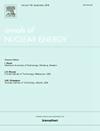Parameter identification of fluid field based on CFD reduced-order model and 3D-Var data assimilation
IF 1.9
3区 工程技术
Q1 NUCLEAR SCIENCE & TECHNOLOGY
引用次数: 0
Abstract
Data assimilation (DA) significantly improves the accuracy of field state and parameter estimation by merging experimental data with predictions from high-fidelity numerical models. However, despite their precision and high resolution, the substantial computational cost associated with these numerical models often hinders their practical application in DA. To overcome this challenge, this study presents a novel three-dimensional variational (3D-Var) DA framework that leverages a reduced-order model (ROM) for boundary parameter estimation in computational fluid dynamics (CFD) models. The framework utilizes Proper Orthogonal Decomposition (POD)-Galerkin projection to construct the ROM, enabling near real-time solutions and significantly enhancing computational efficiency. Furthermore, a nonlinear observation operator is developed within the reduced basis space, which directly connects parameters with observational data. This approach eliminates the necessity for full-state reconstruction, thereby further streamlining the computational process. Benchmark results indicate that the proposed method achieves high accuracy and robustness, offering optimal background information for subsequent state estimation. This advancement not only reduces computational overhead but also maintains the integrity and reliability of the estimations, making it a promising tool for real-time applications in complex fluid dynamics scenarios.
基于CFD降阶模型和3D-Var数据同化的流场参数辨识
数据同化(Data assimilation, DA)通过将实验数据与高保真数值模型的预测数据相融合,显著提高了场态和参数估计的精度。然而,尽管这些数值模型具有精度和高分辨率,但与这些数值模型相关的大量计算成本往往阻碍了它们在数据分析中的实际应用。为了克服这一挑战,本研究提出了一种新的三维变分(3D-Var)数据分析框架,该框架利用降阶模型(ROM)在计算流体动力学(CFD)模型中进行边界参数估计。该框架利用适当的正交分解(POD)-Galerkin投影来构建ROM,实现了接近实时的解决方案,显著提高了计算效率。在简化的基空间中建立了非线性观测算子,将参数与观测数据直接联系起来。这种方法消除了全状态重建的必要性,从而进一步简化了计算过程。基准测试结果表明,该方法具有较高的精度和鲁棒性,为后续状态估计提供了最优的背景信息。这一进步不仅减少了计算开销,而且保持了估计的完整性和可靠性,使其成为复杂流体动力学场景中实时应用的有前途的工具。
本文章由计算机程序翻译,如有差异,请以英文原文为准。
求助全文
约1分钟内获得全文
求助全文
来源期刊

Annals of Nuclear Energy
工程技术-核科学技术
CiteScore
4.30
自引率
21.10%
发文量
632
审稿时长
7.3 months
期刊介绍:
Annals of Nuclear Energy provides an international medium for the communication of original research, ideas and developments in all areas of the field of nuclear energy science and technology. Its scope embraces nuclear fuel reserves, fuel cycles and cost, materials, processing, system and component technology (fission only), design and optimization, direct conversion of nuclear energy sources, environmental control, reactor physics, heat transfer and fluid dynamics, structural analysis, fuel management, future developments, nuclear fuel and safety, nuclear aerosol, neutron physics, computer technology (both software and hardware), risk assessment, radioactive waste disposal and reactor thermal hydraulics. Papers submitted to Annals need to demonstrate a clear link to nuclear power generation/nuclear engineering. Papers which deal with pure nuclear physics, pure health physics, imaging, or attenuation and shielding properties of concretes and various geological materials are not within the scope of the journal. Also, papers that deal with policy or economics are not within the scope of the journal.
 求助内容:
求助内容: 应助结果提醒方式:
应助结果提醒方式:


